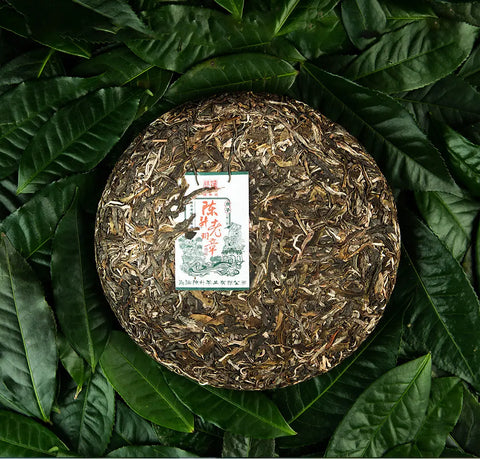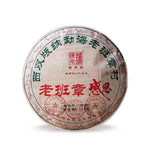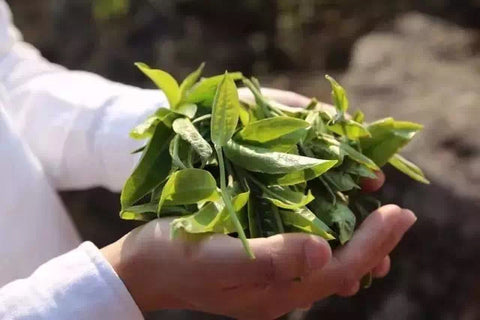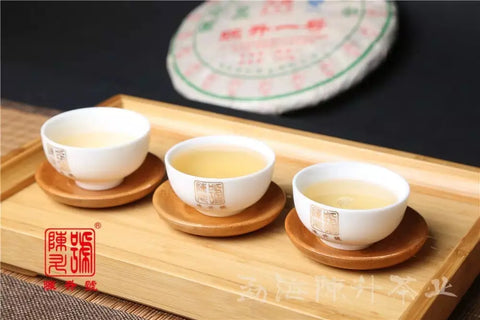Fermented Tea
Fermented tea has a long and rich history, with origins tracing back thousands of years.
Ancient China
In ancient China, tea fermentation began as early as the Tang Dynasty (618-907 AD). This process was initially used to preserve tea leaves for trade and storage.
Trade Routes
Fermented tea gained popularity through trade routes like the Silk Road. It became a valued commodity, exchanged across Asia and eventually reaching Europe.
Bestsellers

2022 Pu-Erh Tea Sample Box (Free Shipping)

2022 Yi Pin Chen Sheng Raw Pu-erh Tea Sample Box

2022 Lao Ban Zhang Raw Pu-erh Tea

2022 Na Ka Raw Pu-erh Tea

2023 Ban Zhang Yin Xiang Raw Pu-erh Tea

2017 Rong Pu Ripe Pu-erh Tea
Cultural Importance
In regions such as Tibet and Mongolia, fermented tea like pu-erh holds cultural significance. It is often consumed during traditional ceremonies and rituals.
Modern Developments
Today's fermented tea ranges from traditional methods to new innovations in flavor and fermentation processes. You can find a variety of fermented teas worldwide.
| Region | Popular Fermented Tea |
|---|---|
| China | Pu-erh |
| Japan | Kombucha |
| Korea | Nokcha |
| Russia | Russian Caravan |
Over centuries, fermented tea not only thrived culturally but also economically. Despite changes in production techniques, its appeal endures.
Types of Fermented Tea

Fermented teas come in various forms, each with unique characteristics and brewing methods. Below, you'll find detailed descriptions of some of the most notable types of fermented tea.
Pu-Erh Tea
Pu-Erh tea is a type of Chinese fermented tea with a deep, earthy flavor. This tea is traditionally produced in Yunnan Province, utilizing a unique fermentation process that can take months or even years. There are two main types: Sheng (Raw) and Shou (Ripe).
Sheng Pu-Erh undergoes a natural fermentation process, while Shou Pu-Erh is artificially fermented to accelerate aging. Both types offer health benefits, such as aiding digestion and reducing cholesterol levels. The aging process significantly affects the tea's flavor profile, making older Pu-Erh teas highly prized.
Kombucha
Kombucha is a popular fermented tea drink made by fermenting sweetened black or green tea with a Symbiotic Culture of Bacteria and Yeast (SCOBY). The fermentation process produces a tea with a tangy, slightly effervescent character. It's often flavored with fruits, herbs, or spices during a secondary fermentation stage.
You can find kombucha in various commercial brands, or make your own at home. This tea is touted for its potential health benefits, including probiotics that promote gut health and antioxidants that may help in detoxification. Despite its strong flavor, it's enjoyed by many for its refreshing taste and potential wellness advantages.
Jun Tea
Jun tea is similar to kombucha but is made by fermenting green tea with raw honey instead of black tea and sugar. Known as the "champagne of kombucha," Jun tea has a lighter, more delicate flavor profile. Like kombucha, it uses a SCOBY for fermentation.
Jun tea is reputed to offer similar health benefits to kombucha, such as supporting digestive health and boosting the immune system. Its mild taste often appeals to those who find kombucha too strong. You can experiment with different flavors by adding fruits and herbs during the brewing process.
Sourdough Kvass
Sourdough Kvass is a lesser-known fermented tea made by brewing tea with sourdough bread. This unique process gives the tea a mildly tangy and slightly malty flavor. The sourdough starter, rich in wild yeasts and bacteria, is used to ferment the tea.
Lao Ban Zhang

2024 Lao Ban Zhang Ripe Pu-erh Tea

2022 Lao Ban Zhang Raw Pu-erh Tea

2023 Ding Feng- Lao Ban Zhang Raw Pu-erh Tea (42g)

2024 Xiao Ban Zhang Raw Pu-erh Tea

2020 Lao Ban Zhang Raw Pu-erh Tea 125g

2025 Lao Ban Zhang -Gan En Raw Pu-erh Tea 357g
The result is a drink that's both refreshing and probiotic-rich. It's known for its potential benefits, including supporting digestive health and providing a unique taste experience. The combination of tea and sourdough offers a distinctive flavor that sets it apart from other fermented teas.
By exploring these types of fermented tea, you can find options that suit your taste while enjoying various health benefits.
Cultural Significance

Fermented tea holds a unique position in various cultures, influencing social practices, daily routines, and even religious rituals. Its historical roots run deep across continents, shaping the way people brew, share, and cherish their tea.
Fermented Tea in China
In China, fermented tea, particularly pu-erh, has deep historical and cultural ties. It has been consumed for centuries for its health benefits and has been used in traditional Chinese medicine. The tea is often aged, with older batches being highly prized and sometimes used as a form of currency.
Social Significance: Tea ceremonies play a crucial role in Chinese culture, with pu-erh being central to these rituals. These ceremonies emphasize mindfulness and social bonding.
Religious Impact: Monks and temples have historically used fermented tea in their daily routines for its supposed calming properties.
Fermented Tea in Japan
Japan's association with fermented tea largely centers around kombucha, which differs significantly from the Chinese variant despite sharing the same name. Kombucha, a fermented drink made from tea, sugar, bacteria, and yeast, is known for its health benefits.
Historical Context: Introduced from China, kombucha gained popularity in Japan during the early 20th century. It was believed to be an elixir for longevity and health.
Modern-Day Relevance: Today, kombucha's popularity in Japan spans from traditional households to contemporary wellness circles, often consumed for digestive health and its probiotic properties.
Fermented Tea in Russia
In Russia, fermented tea is synonymous with "Ivan Chai," a traditional fermented herbal tea made from fireweed. This tea offers a different flavor profile and set of traditions compared to Asian fermented teas.
Traditional Practices: Ivan Chai has been part of Russian culture for centuries and was widely consumed before the introduction of black tea. It's considered a staple in many rural communities.
Cultural Revival: There's a modern resurgence of interest in Ivan Chai, seen as a return to traditional and natural health practices. It's increasingly featured in cultural festivals and local markets.
Fermented tea thus holds a unique and cherished place in the cultural landscapes of China, Japan, and Russia, each with its distinct traditions and contemporary significance.
Production Processes

The production of fermented tea involves several detailed steps, from selecting the right leaves to carefully controlling fermentation and drying.
Harvesting and Selection of Leaves
The initial step in fermented tea production is the careful harvesting of tea leaves. You must choose the leaves at the right stage of growth, typically young and tender ones. Quality and timing are crucial as these factors significantly affect the final flavor and aroma.
Farmers generally hand-pick the top two leaves and a bud from tea bushes. This selective plucking ensures only the best leaves are used. After harvesting, leaves undergo a selection process to remove any damaged or unsuitable ones, ensuring only high-quality leaves proceed to the next stages.
Oxidation and Fermentation Techniques
Once you have the selected leaves, the oxidation process begins. This involves wilting the leaves to reduce moisture content. Controlled oxidation is key, as it impacts the tea's flavor profile. Leaves are spread out in thin layers and allowed to interact with the air, where enzymatic reactions occur.
Fermentation in tea processing differs from traditional fermentation since it doesn't involve microorganisms. It's mainly chemical reactions within the leaves. You must monitor temperature and humidity closely to achieve the desired flavors and aromatic compounds.
Drying and Aging Processes
Drying is a crucial step after fermentation. It halts oxidation and stabilizes the tea. Common methods include sun drying, hot air drying, and pan-firing. Each method influences the tea's flavor and quality differently. You need to ensure the leaves are dried uniformly to avoid any uneven flavors.
Aging can also add complexity to fermented teas. Some teas are aged for months or even years under controlled conditions. This process allows further development of flavors and can enhance the tea's depth and character. Proper storage is essential during aging to maintain quality.
Brewing Techniques
Brewing fermented tea involves various methods, from the meticulous traditional practices to the innovative modern approaches. Each method influences the taste, quality, and health benefits of the tea.
Traditional Brewing Methods
Traditional brewing relies on time-honored practices passed down through generations. One key technique is fermentation in large, open clay pots. These pots provide a unique environment for natural microbes to thrive.
The tea is often left to ferment for several weeks. Temperature control is crucial for maintaining consistent fermentation and preventing spoilage. Additionally, tea masters routinely monitor the tea's pH levels.
Ingredients typically include tea leaves, sugar, and a SCOBY (Symbiotic Culture of Bacteria and Yeast). It's important to maintain a hygienic environment to avoid contamination.
Modern Brewing Variations
Modern brewing introduces technological advancements to traditional methods. One popular approach is using fermentation vessels with built-in temperature and pH controls.
These vessels often feature airlocks to maintain anaerobic conditions. The brewing process is optimized using data-driven techniques. Automation plays a significant role in ensuring consistent quality and flavor.
Ingredients remain similar but can include various flavor infusions such as fruit juices or spices. Technology also facilitates small-batch production and experimentation with fermentation times and temperatures.
These modern methods aim to enhance efficiency and product consistency.
Taste Profiles and Pairings
Fermented tea offers a diverse array of flavors, from complex and bold to subtle and refreshing. Understanding these flavors helps in pairing them with complementary foods to enhance your tasting experience.
Flavor Notes
Kombucha: This fermented tea often has a tart, tangy flavor with a hint of sweetness. Flavors can vary based on the ingredients used during fermentation, such as fruits, herbs, or spices.
Pu-erh Tea: This type emits earthy, woody, and sometimes musty notes. Some describe it as similar to mushrooms or the forest floor. It's known for its deep, mellow, and sometimes slightly sweet flavor.
Jun: A cousin to kombucha, made with green tea and honey. Jun tastes lighter and less acidic, often with floral undertones.
Comparing these a few of the options:
- Light Flavors: Jun, Kombucha with fruits.
- Bold Flavors: Pu-erh Tea.
Food Pairing Suggestions
Kombucha: Pairs well with light salads, mild cheeses, and fresh fruits. The acidity of kombucha can balance rich, fatty foods like avocado or a cheese platter.
Pu-erh Tea: A perfect match for savory dishes. It complements hearty meals like stews, roasted meats, or even aged cheeses due to its rich, deep flavors.
Jun: Ideal for pairing with delicate flavors. Think of honey-glazed chicken, rice dishes, or light desserts like lemon tarts.
Here are combinations to consider:
- Kombucha with: green salads, cheddar cheese, mango slices.
- Pu-erh Tea with: beef stew, lamb, brie cheese.
- Jun with: rice pilaf, poultry dishes, lemon meringue pie.
Global Market and Trade

The global market for fermented tea, often known as kombucha, has seen exponential growth. This growth is driven by rising consumer awareness about health benefits and preference for natural beverages. Major markets include North America, Europe, and parts of the Asia-Pacific region.
North America is one of the largest markets. Many startups and established beverage companies are investing heavily in kombucha to meet consumer demand.
In Europe, kombucha is steadily gaining popularity. Countries like the United Kingdom, Germany, and France are leading in consumption.
Asia-Pacific shows promising growth potential. Traditional tea-drinking cultures in countries like China and Japan are contributing to this trend.
Key players in the market include:
- GT’s Living Foods
- Health-Ade Kombucha
- KeVita
- Brew Dr. Kombucha
Market Trends:
- Product Innovation: Companies are introducing new flavors and variations to attract a broader audience.
- Sustainability: There is a growing emphasis on eco-friendly packaging and organic ingredients.
- Health Trends: Increasing focus on health and wellness continues to drive demand.
| Region | Market Share % (2023) |
|---|---|
| North America | 45% |
| Europe | 30% |
| Asia-Pacific | 20% |
You can expect further market expansion as more people become aware of the benefits of fermented tea.
Storage and Preservation
Fermented tea requires careful storage to maintain its quality. Store it in a cool, dark place, away from direct sunlight.
Use airtight containers to prevent exposure to moisture and air. Glass jars, tin canisters, or vacuum-sealed bags work well.
Store at a stable temperature. Fluctuations can affect the tea's flavor and longevity.
Ideal storage conditions:
- Temperature: Below 25°C (77°F)
- Humidity: Below 60%
Avoid storing near strong odors. Fermented tea can absorb smells, which may alter its taste.
Label your containers with the date. This helps track the aging process and ensures you consume it at its peak.
For long-term preservation, consider refrigerating or freezing. Use airtight, moisture-proof packaging to avoid freezer burn.
Regularly check your stored tea for signs of mold or spoilage. Discard any affected batches immediately.
← Older post Newer post →
